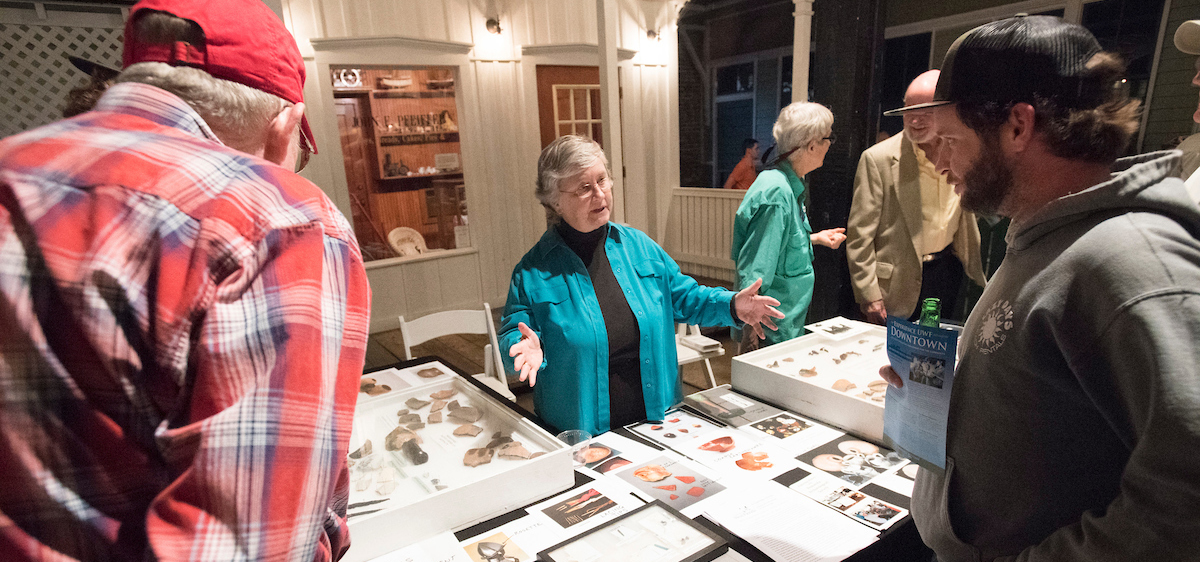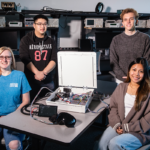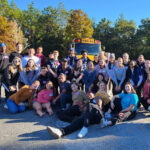Archaeologists Gather to Discuss Luna Settlement, Wrecks
Pensacola – A standing-room only crowd turned out Feb. 1 to hear details and view artifacts from both the shipwrecks and land settlement associated with the 16th-century Spanish expedition led by explorer Don Tristán de Luna y Arellano.

The presentation and panel discussion by University of West Florida faculty called “Archaeology of the Luna Expedition in Pensacola” was held at the Museum of Commerce as part of the Experience UWF Downtown Lecture Series presented by the UWF College of Arts, Social Sciences and Humanities.
Tristán de Luna y Arellano attempted to establish a Spanish colony in Pensacola in 1559. A hurricane struck five weeks after the expedition arrived, sinking seven of the ships in the Luna fleet.
A team with the Florida Bureau of Archaeological Research, under the direction of Dr. Roger Smith, discovered the wreckage of one of those ships, called Emanuel Point I, in 1992.
Then, in 2006, UWF archaeologists discovered the remnants of a second ship, called Emanuel Point II.
In December 2015, the UWF archaeology program identified the location of the Luna land settlement.
“The Luna settlement site is in a Pensacola neighborhood with 100 percent private land,” said Dr. Elizabeth Benchley, director of the Division of Anthropology and Archaeology and the Archaeology Institute. “We have contacted over 120 property owners for permission to search for evidence of Luna on their land, and so far only five owners have turned us down. So this is truly an amazing neighborhood, and we are very grateful to them all.”
Dr. John Worth, an associate professor of anthropology at UWF who along with Benchley serves as the principal investigators of the Luna settlement site, told the audience about the hardships the colonists faced after the devastating hurricane.
“In the aftermath, the colonists dredged up what they could, picked the wrecks clean,” Worth said. “Indeed they actually pulled apart some of the lumber and built two brigantines to be able to travel along the coast, and so they spent the next two years ultimately trying to survive.
Because the bad thing about the original hurricane was that the Spaniards left all the food for 1,500 people on board the ships, because they believed the fleet was a more protected location compared to the land settlement during those first five weeks.”
Benchley said materials from the Luna land settlement so far have been found across at least nine city blocks or 27 acres.
The excavation on Emanuel Point I shipwreck included the discovery of an actual breastplate from a suit of armor, Mexican-Indian pottery and the hull of the wreck itself, considered one of the larger vessels lost in the hurricane, said Dr. Gregory Cook, assistant professor of anthropology. Emanuel Point II was discovered by a magnetometer survey during a UWF summer field school, said Cook, who is the principal investigator for the shipwreck site.
“It’s been an exciting period of field work with many new finds on (Emanuel Point II) including large amounts of pottery, stone cannonballs and other artifacts,” Cook said.
In June 2016, UWF archaeologists discovered a third shipwreck, Emanuel Point III, during a combined archaeological field methods course.
“We just barely scratched the surface, this is closer to shore and in shallower water than the other two,” Cook said. “We don’t know if it’s fragmented. But we definitely have intact shipwreck structure, underneath ballast and artifacts dating to the right time period to be another Luna shipwreck.”
Dr. John Bratten, chair and associate professor of anthropology, said the most common discoveries made from the Luna sites are pottery. The artifacts are found in varying conditions, and some require more research and cleaning in the lab.
“The rule of thumb is for every two months you’re going to spend in the field you’re going to spend a year in the lab,” Bratten said. “We make as many discoveries in the lab as we do in the water.”
Dr. Ramie Gougeon, assistant professor of anthropology, said he’s studying the centuries before Luna’s arrival, attempting to discover the different identities and ethnicities of people who came through the area by using the artifacts that are found.
“I feel my part of this larger project is trying to figure out who was here in late prehistory and then what became of them. Where did they go, who came in after them and how could we tease out this very dynamic period of people moving around the Pensacola Bay region around the time of contact and afterwards,” Gougeon said.
Dr. Della Scott-Ireton, associate director of the Florida Public Archaeology Network, told the audience about the public outreach and education FPAN and UWF has done for the Luna discoveries, including exhibits, lectures, multimedia presentations and even tours of the land and shipwreck sites.
A public archaeology lab was also set up in a home that UWF rented and used as the field headquarters for the Luna settlement site.
“That enabled folks to come out and help us with the lab, process and analyze the artifacts as they come out of the field,” Scott-Ireton said.



